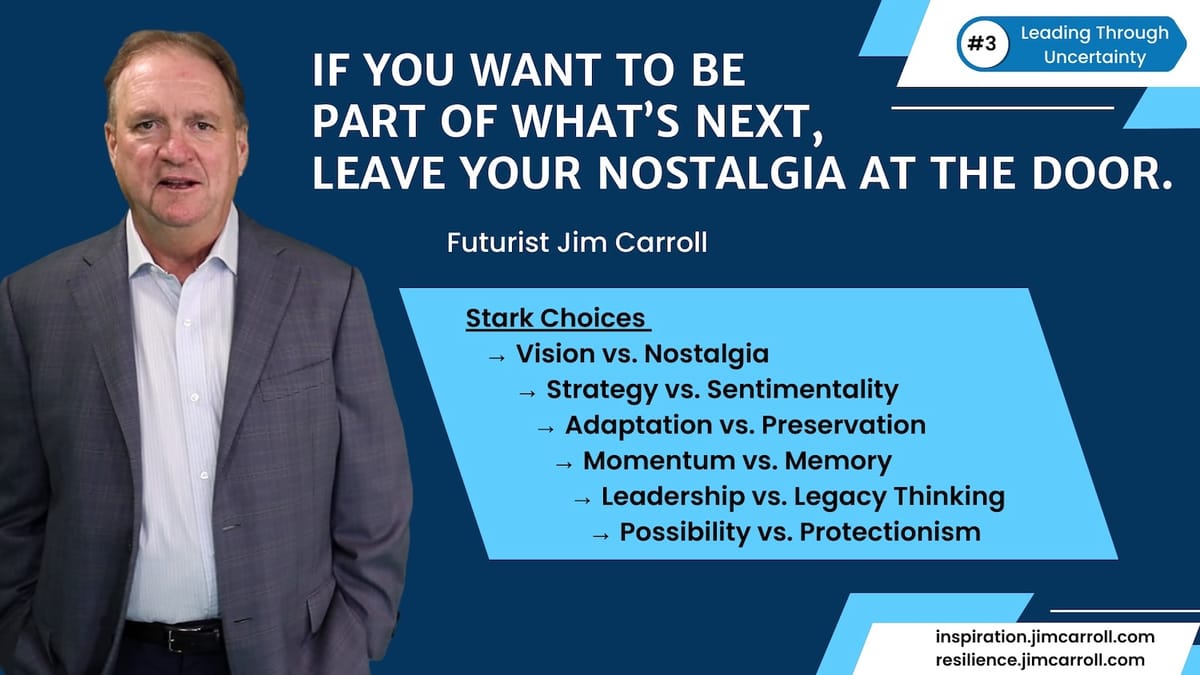You need to commit.
Yesterday, or tomorrow?
I know where I'm going. It's in my job description.
Think about it - at this very moment, we’re witnessing a battle playing out everywhere—across boardrooms, governments, industries, at parties and sports events and family get togethers. The battle is being driven by a vainglorious and ill-fated desire to try to take things back to where they were - not to where they are going.
And one of the most important things you need. to do is make your decision - and stick to it - as to where you are headed.
It's a battle of vision vs. nostalgia.
Of strategy vs. sentimentality.
Of building what’s next vs. longing for what was.
It's really not a fair fight.
We’ve reached a point where the familiar is failing - old industries are dying, old skills are becoming irrelevant, old knowledge is going out of date, old jobs are disappearing. In the context of that? New industries, skills, knowledge, jobs - and new opportunities.
It's called disruptive change, and it is very real. The new rule is that older stable ideas aren’t stable. Playbooks that were once reliable aren’t playable. Assumptions and strategies that served the past no longer serve the future. The fact is, the world’s moving faster than our old systems were designed to handle.
And yet—some still cling to the comfort of past success like it’s a security blanket.
But nostalgia is not a strategy. It’s a sedative.
In a world that demands reinvention, clinging to the past is a slow form of decline.
If you want to lead your team, your business, or even yourself through this moment, the answer isn’t to “get back to normal”—it’s to get better at what’s next.
We now know what works:
- businesses that embrace change and actively adapt their models during crisis (anti-fragility) bounce back stronger.
- leaders who let go of the expectation to “have all the answers” and instead lean into learning, agility, and reinvention are that find the new answers
- companies that invest in innovation—process, product, and purpose—capture opportunity while others fall behind
- olong-term success is built by those who protect future-facing investments like R&D, automation, digital, and customer insight—even when it's tempting to cut them.
Look at the companies that missed the future—Kodak. Blockbuster. Blackberry. Their downfall wasn’t a lack of resources. It was a devotion to the past that blinded them to the signals of change. When you think about it, that's exactly what is happening at this moment in time with Tesla - with their CEO so caught up in fighting a different battle that has ceded the future of electric vehicles to China.
Recessions and disruptions are not the time to shrink your ambition. They’re a time to reshape it.
So ask yourself: Are you holding onto what used to work—or reaching for what could?
The future doesn’t wait for comfort. It rewards courage.
And if you want to be part of what’s next, leave your nostalgia at the door—and bring your blueprint for tomorrow. That's because this moment isn’t just about letting go of nostalgia, it's about trading old mindsets for future-ready ones:
- Vision vs. Nostalgia – Stop looking back. Start looking ahead.
- Strategy vs. Sentimentality – Reality over drama. Direction over emotion.
- Adaptation vs. Preservation – Evolve or risk irrelevance.
- Momentum vs. Memory – Motion matters more than history.
- Leadership vs. Legacy Thinking – Reinvent the rules—even the ones that made you.
- Curiosity vs. Complacency – Exploration fuels relevance. Routine kills it.
- Possibility vs. Protectionism – The future doesn’t reward playing it safe.
If you’re still trying to bring back the past, you’re already behind.
The future belongs to those who are ready to reshape it—one decision, one mindset shift, one bold move at a time.
Leave your nostalgia at the door. And walk into what’s next.
Futurist Jim Carroll spoke at dozens of leadership meetings post ’01, again in ’08, and guided organizations again in ’20. He’s developed a comprehensive overview of how to move forward, not back, during an era of uncertainty. It’s being shared here and documented at https://tomorrow.jimcarroll.com

